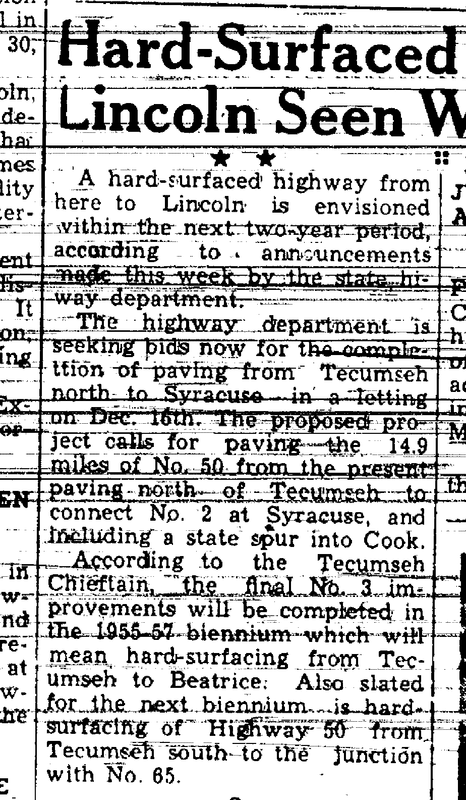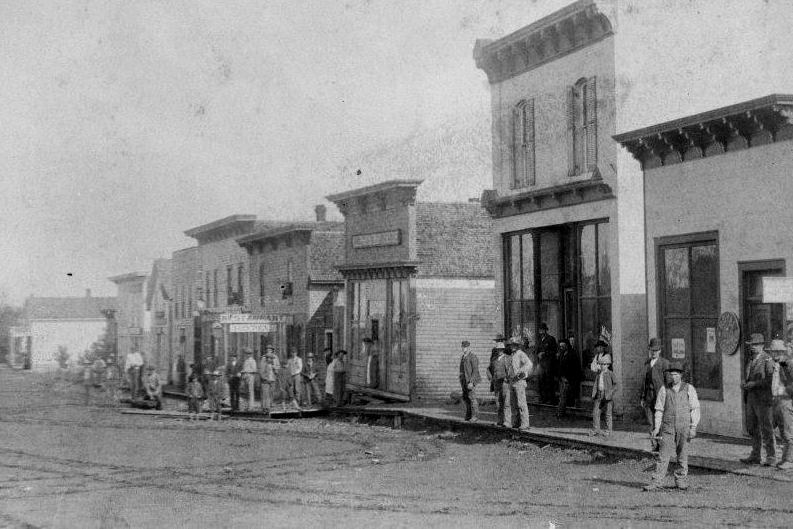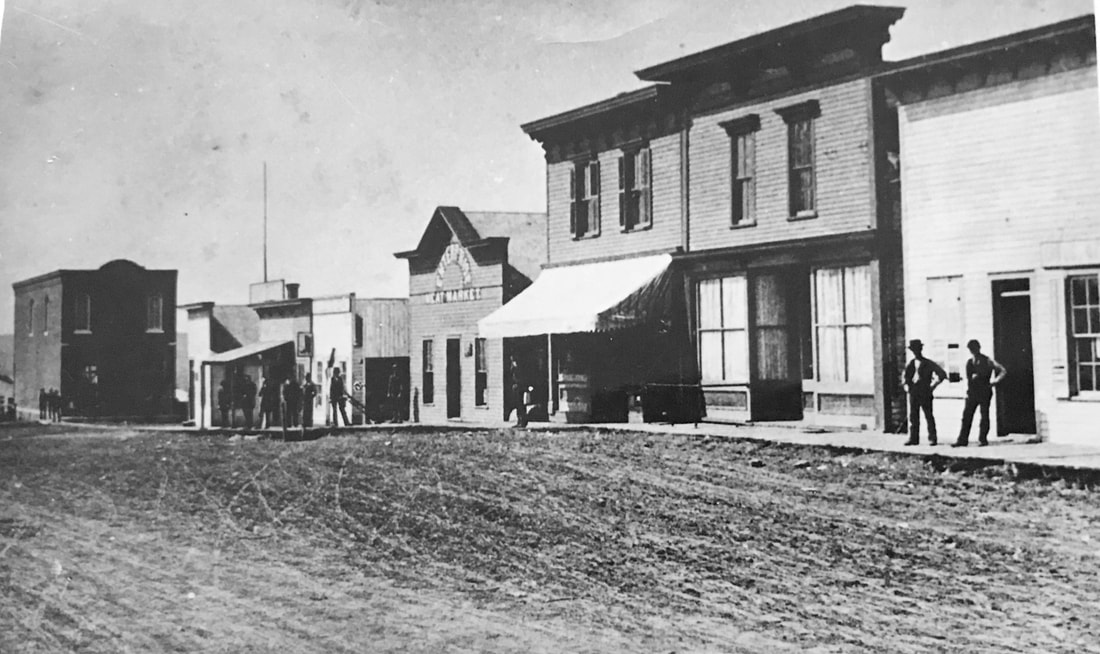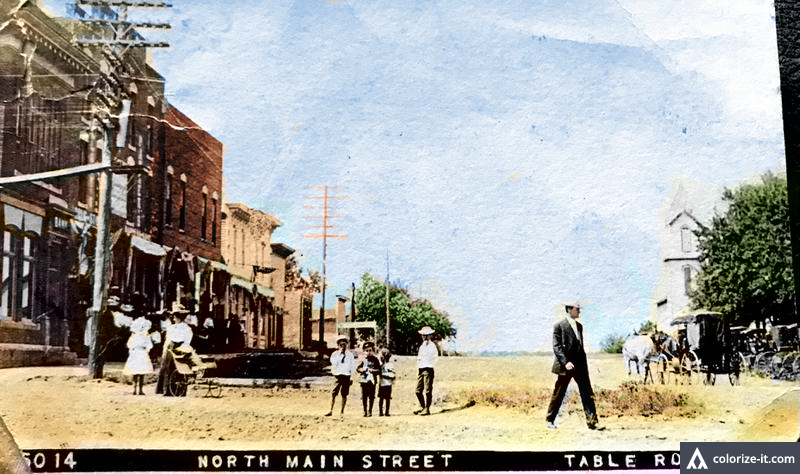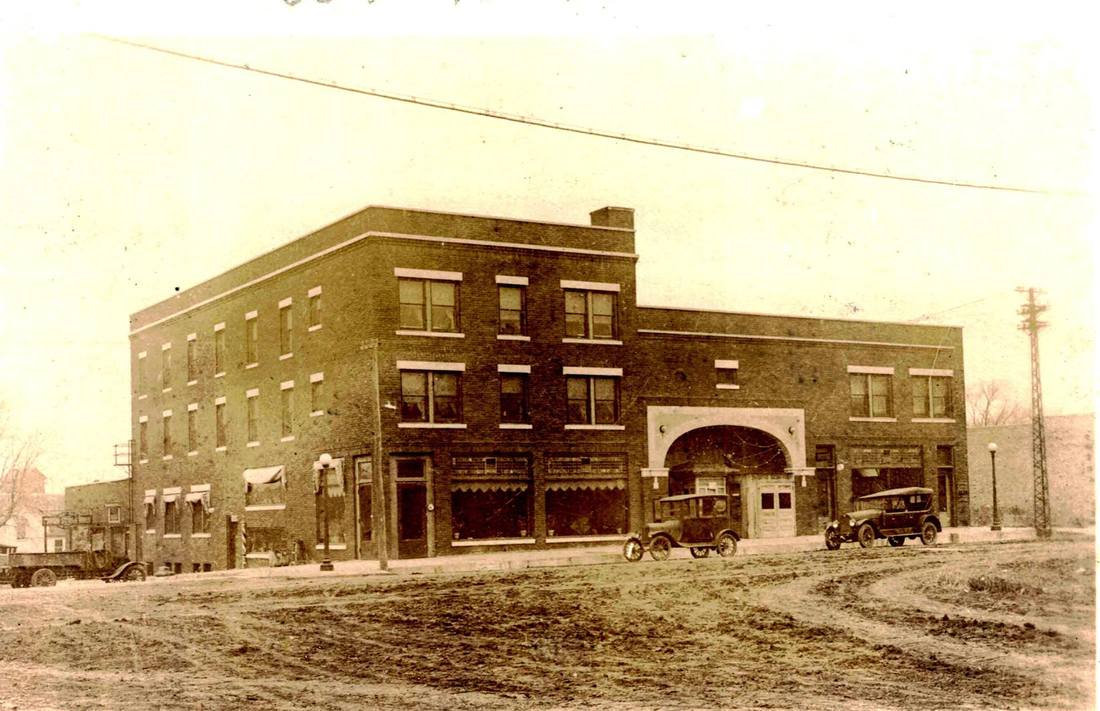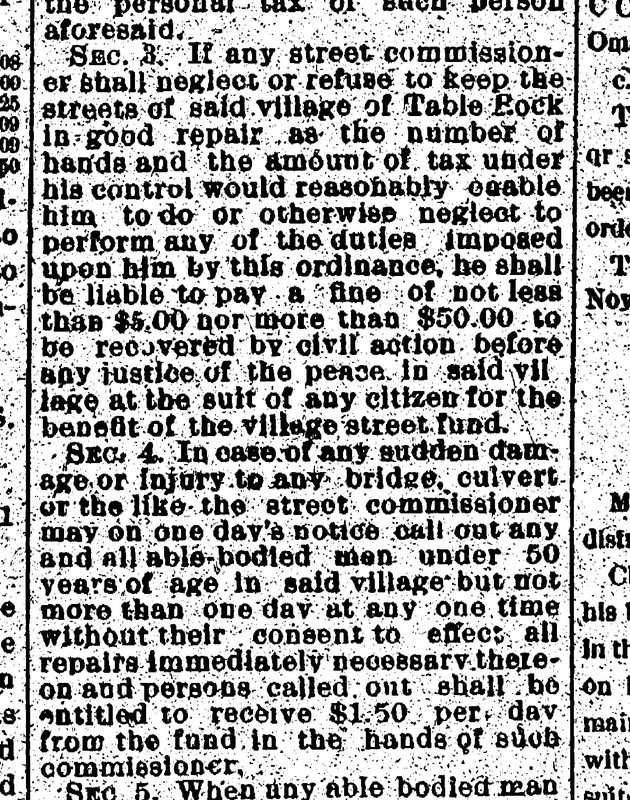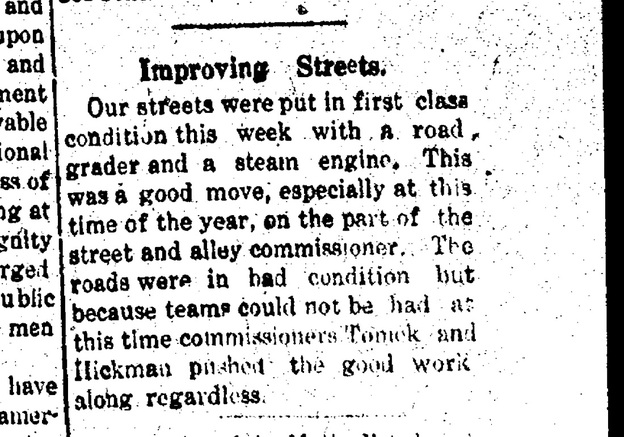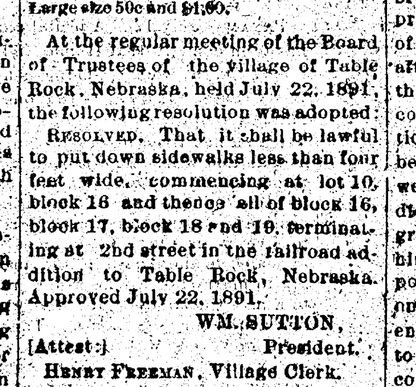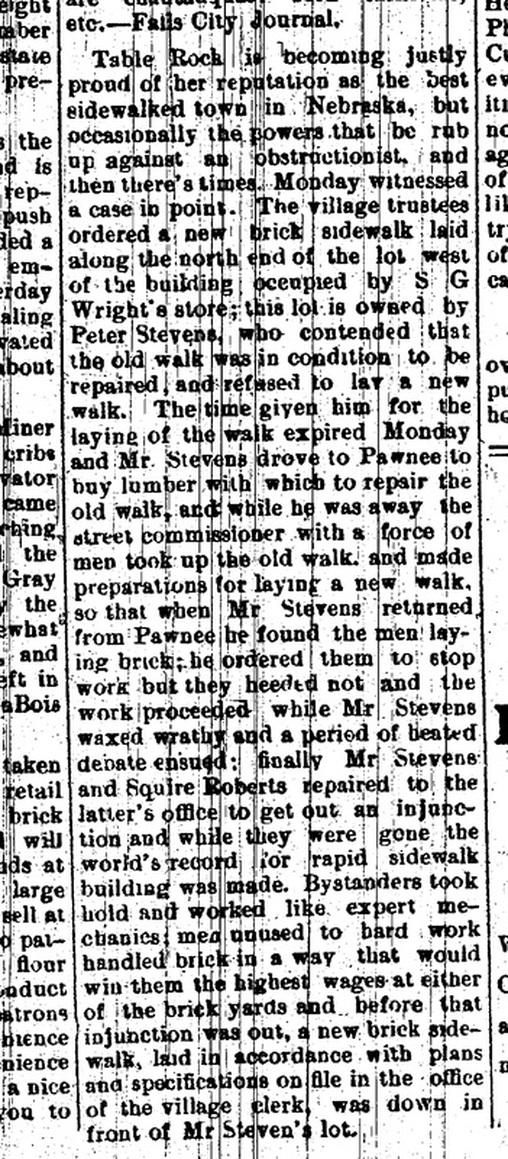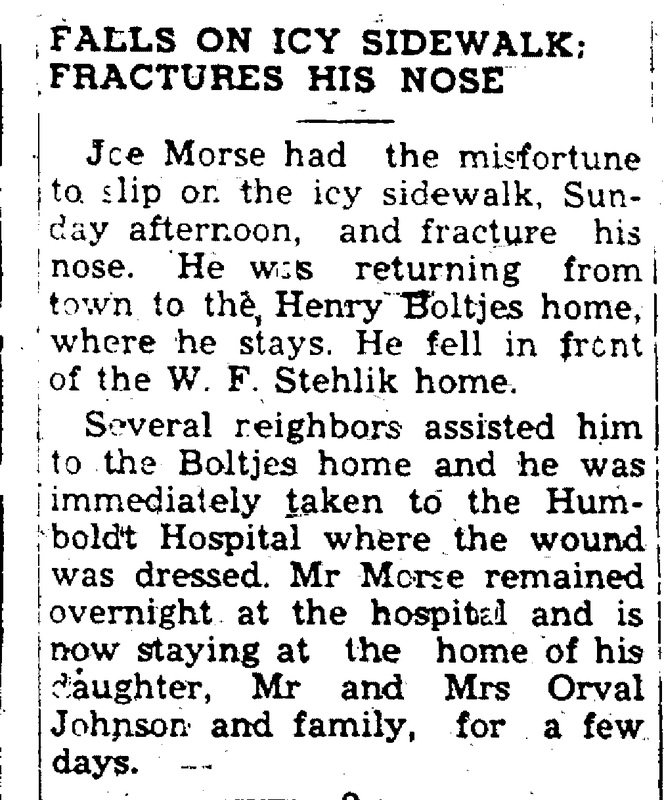Streets & Roads & sidewalks
ROADS
the 1939 memoirs of elsie pepoon describe early travel
In her memoir about Bunker Hill, Elsie described early travel:
how to maintain a road? start with a span of mules.
This is Ernest Frank road dragging, i.e., an early form of grading the road. Thanks to Brenda Frank, who posted this on Facebook. Photo 1420
1920 - prison labor builds roads
1941 - a brand new highway coming in from east - work begins on the bridge on which it will cross the nemaha
Above is Photo 3028, the present bridge over the Nemaha being built, shared by Steve Russell of Chattanooga, Tennessee. He sent it to us in October 2016 with this note:
Hello,
I was going through some old pictures from my father’s estate and found this picture that you might be interested in. The description on the back reads, “Piers for bridge across Nemaha River east of Table Rock, Nebr., April, 1941.”
My father, Ross Russell, was raised in Nemaha County (Nemaha and Peru).
Hope you can find a place on your website for this.
1948 - infrastructure at the theater! the road to rio.
1954 - a hard-surfaced highway all the way to lincoln! Oh my!
streets
in town - dirt streets, board sidewalks
ABOVE: 1887, Luzerne Street, south side of the Square. Thank you to Historical Society member Kim Vrtiska for finding this great picture; a copy was subsequently found with the date. Note the board sidewalk, the dirt street. That frame building on the far right was replaced by the brick Argus building in 1894, but the store to its left is still there -- Sochor Electric was in it for MANY years. In 2016/2017, Harry Griebling Photography took over after the death of beloved charter Historical Society member Joe Sochor.
BELOW: 1887, Houston Street, west side of the Square, shared by Cara Harris Davis. Photo 8032.
Note the weeds growing in the street!
MORE ABOUT THE STREETS
1890 - ordinance no. 16 -- an ordinance about paying labor & personal tax in the village of table rock, nebraska
This amazing ordinance had some very unusual provisions!!!!! It was published in the October 20, 1890 Argus. It provided that it was to take effect "on and after approval and publication." The surviving Argus editions are spotty in that time period. Did the ordinance go into effect? Don't know.
sECTION 1. ROAD TAX & 75% Of PERSONAL TAX TO BE PAID WITH.....LABOR!
section 2. all who appear get paid $1.50 for 8 hours labor and $1.50 for each span of horses, mules, or oxen used.
The street commissioner was given the duty to notify "all" persons "when and where to work" to pay their "labor tax" and 3/4 of their personal tax, "and with what implements." If they showed up and if they worked 8 hours, they got paid and they got their taxes discharged.
section 3: the street commissioner gets fined if he doesn't keep the streets up as expected!
SECTION 4: ALL ABLE BODIED MEN UNDER AGE 50 COULD BE CALLED OUT IN THE EVENT OF "SUDDEN DAMAGE" OF ANY BRIDGE OR CULVERT
If we only had such laws today -- they might be implemented at a national level!
section 5: able bodied men fined if they (or a substitute) don't appear when summoned
sections 6 & 7: railroads must keep crossings and bridges in good repair, and street commissioner will give them notice as needed
1912 - road grader & steam engine at work on the streets
1915 - streets blocked on halloween "in the usual way."
1954 envisioning a hard-surfaced highway all the way to lincoln! oh my!
1957 - gravel & rock for the streets, just the thing
June 1957 - Streets to get gravel and rock! It should put them in good condition "again." Councilmen Layden and Mertes mentioned.
SIDEWALKS
1891
sidewalks less than 4 foot wide ok butonly in certain places
1891 - Village board says lawful to put down sidewalks less than four feet wide -- at select places
1898 - ordinance 35 -- getting rid of wooden sidewalks
From a clipping that looks back 75 years. Go toward the bottom & look at the description of Ordinance 35.
1898 - ordinance 36, no bicycles on the sidewalk!
october 1898 - peter stevens refused to replace a sidewalk on the ground that it can be repaired, and what happened.
Forgot to write down which paper this was from, but it's too good not to share. Earlier in 1898, Table Rock had passed an ordinance that any sidewalk that needed to be replaced had to be replaced with one of brick or comparable material. Wood sidewalks could not be replaced with wood sidewalks. Peter Stevens had a wood sidewalk that was apparently in front of a commercial lot. The lot was on the north end of the lot west of the building occupied by S. G. Wright's store. Where was S. G. Wright's store in 1898? Stevens was ordered to put in a brick one. He said heck no, it can be repaired. He headed for Pawnee City to get the lumber to repair it. Immediately, the street commissioner swung into action, and bystanders jumped in with enthusiasm as well!
circa 1915 --
sidewalk at taylor branch bridge, entering lower town
This appears to be the brick sidewalk going east toward Lower Town and the depot. Taylor Branch is in flood stage, probably the 1915 flood when comparing with other photographs.
1921 - no bicycles allowed on the sidewalks!!!!! Marshal Phillips, "I don't want to arrest anyone, but riding bicycles on the sidewalks must cease!"
1951 - joe morse falls on a sidewalk
Joe Morse falls on the sidewalk in front of the W. F. Stehlik home, breaks his nose!





